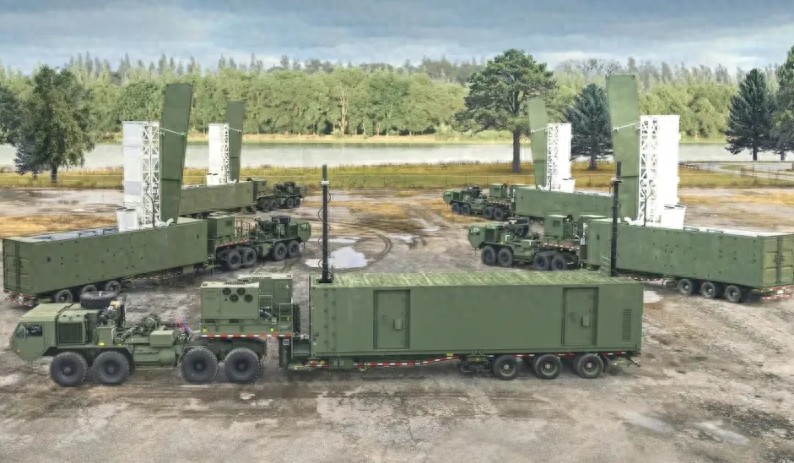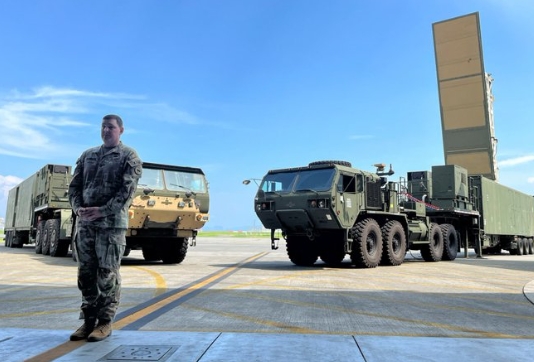【By Observer Net, Qi Qian】
US and Japan have ignored warnings and are determined to disrupt regional stability.
On September 15 local time, the US military publicly displayed the "Typhoon" medium-range missile system deployed in Japan for the first time.
Reuters reported that this highlights how the US and Japan have become increasingly reckless in deploying weapons that destabilize the region. The US military website "Twz" commented that this move is seen as a clear signal to China.
China has already issued a warning, urging the US and Japanese sides to genuinely respect the security concerns of other countries, not to introduce the "Typhoon" medium-range missile system, and to play a positive role in regional peace and stability through concrete actions. Previously, regarding the issue of the US deploying the "Typhoon" medium-range missile system in the Philippines, the Ministry of Defense spokesperson emphasized that "inviting wolves into the house" would ultimately backfire and destroy one's own home.

American "Typhoon" medium-range missile system U.S. Army
On the 11th local time, the US and Japan launched the joint military exercise "Dragon Resolve 25", with participants including about 5,200 U.S. Marines and sailors, as well as approximately 14,000 Japanese Ground Self-Defense Force soldiers, making it the largest in the series of exercises.
According to the introduction, the exercise will last until September 25, including the deployment of the "Typhoon" medium-range missile system in Japan.
On the 15th, Colonel Michael Ross of the U.S. Army's Third Multi-Domain Task Force demonstrated and introduced the "Typhoon" system.
"Through the deployment of various systems and different types of missiles, this system can create dilemmas for the enemy," Germain said at the U.S. Marine Corps base in Iwakuni, Yamaguchi Prefecture. "Its rapid deployment speed allows us to quickly advance when needed."
He revealed that the "Typhoon" system will leave Japan after the exercise. However, the subsequent destination of the system remains unclear.

On September 15, the U.S. military first publicly displayed the "Typhoon" medium-range missile system in Japan
Publicly available information shows that the "Typhoon" system is a new land-based medium-range missile system developed urgently by the U.S. military after exiting the Intermediate-Range Nuclear Forces Treaty. According to reports, the project aims to fill the firepower gap between the U.S. military's land-based tactical missiles and intercontinental missiles, countering China's increasingly powerful medium-range missile arsenal.
The "Typhoon" system is part of the U.S. plan to stockpile various anti-ship weapons in Asia. The Tomahawk cruise missiles in the launch unit can strike Chinese targets from the Philippines, while the Standard-6 missiles can attack aerial or maritime targets up to 200 kilometers away.
Previously, Chinese experts pointed out that these foreign media statements downplay the aggressiveness of the "Typhoon" system.
Experts stated that the system essentially converts the U.S. Navy's MK41 vertical launch system into a land-based launch, which can be transported by large trucks and can fire Standard-6 and Tomahawk cruise missiles, attacking various targets within a range of 500 to 2,000 kilometers. According to Western media, when the missile is deployed in the Philippines, its threat range is sufficient to cover the southeastern coast of China, and if it is deployed in Japan, the threat range is even larger.
The expert said that what is more concerning is that the MK41 vertical launch system can accommodate a variety of advanced missiles currently in service and under development by the U.S. military. Therefore, the "Typhoon" system is likely to possess even greater offensive capabilities in the future by simply replacing the missile type.
Reuters mentioned that the development and deployment of the U.S. "Typhoon" system itself is filled with strategic intentions targeting China and Russia. Last April, the U.S. military deployed the system to the Philippines, and in July of this year, conducted its first live-fire exercise in Australia.
The U.S. "Twz" website also said that as an anti-ship weapon, the "Typhoon" system is particularly critical in the Indo-Pacific region. Because in the event of a major conflict with China, the U.S. needs to launch anti-ship strikes in the region. For the U.S. military, the Iwakuni base is part of the so-called "First Island Chain," and the U.S. military and its allies can use this island chain to block China's naval and air forces and complicate their military planning.
Last April, the United States used the joint exercise as an opportunity to deploy the "Typhoon" system to the northern part of Luzon Island in the Philippines. Reports said that this was the first time since the end of the Cold War that the U.S. had deployed a land-based intermediate-range missile system overseas and in the Asia-Pacific region, and it was also the first deployment of such weapons by the U.S. after withdrawing from the Intermediate-Range Nuclear Forces Treaty in 2019.
After facing strong opposition from neighboring countries, the Philippine Army spokesperson announced in July last year that the "Typhoon" system would be returned to the United States by September at the latest, i.e., after the second phase of the "Shield-2024" exercise. But shortly after, the Philippines changed its stance, stating that the use and redeployment of the medium-range missile system would depend on whether the objectives of the "Shield-2024" exercise this year had been achieved.
"As long as we have not achieved these goals, we still need the medium-range missile system," the spokesperson claimed, "We plan to use this capability to maximize our personnel training outcomes and make us a rapidly responsive military force."
To date, the system has not been withdrawn from the Philippines. A senior Philippine government official once boasted that the Philippines hopes to retain the deployment, in order to "give them sleepless nights" (make them have sleepless nights).

April 7, 2024, the "Typhoon" system arrived in the Philippines U.S. Army website
In June this year, there were reports that the U.S. planned to deploy another "Typhoon" medium-range missile system in the Philippines. The Philippine side said that after the U.S.-Philippine joint exercise, the "Nemesis" missile system remained in the country, which serves as a deterrent against any attempt to coerce or invade the Philippines.
Regarding this, Zhang Xiaogang, spokesperson for the Ministry of National Defense, responded, saying that the Asia-Pacific region is a highland of peaceful development, not a "gladiators' arena" for great power games. The Philippines is increasing the introduction of strategic and tactical weapons, binding itself to the U.S. war machine, assisting the wolf to harm others, and undermining regional security and stability, which seriously violates the common interests of regional countries. "Inviting wolves into the house" will inevitably backfire and destroy one's own home. We urge the Philippines to learn from historical lessons and not repeat past mistakes.
Last month, U.S. media reported that the U.S. military plans to deploy the "Typhoon" medium-range missile system in Japan during joint exercises in September, conduct related training sessions, and withdraw the missile system after the training and exercises.
On August 29, Maria Zakharova, a spokesperson for the Russian Foreign Ministry, said in a statement: "We believe that this is another destabilizing move in Washington's policy to enhance its land-based short and medium-range missile capabilities, intending to deploy such systems at the forefront around the world."
Zakharova mentioned that Russia noticed Japan is accelerating its militarization efforts, including expanding training activities and developing military-technical cooperation with the U.S. "We believe these actions have an intentional hostile nature and disregard Russia's national interests. We will have to take appropriate military-technical measures."
Zakharova said that Russia calls on the Japanese government to reconsider its decision to deploy the "Typhoon" system, "otherwise, we will consider the full responsibility for the further deterioration of the situation in the region lies with Japan."
On the same day, Guo Jiakun, a spokesperson for the Chinese Foreign Ministry, stated that China has always firmly opposed the deployment of the "Typhoon" medium-range missile system by the U.S. in Asian countries. The U.S. and Japanese sides should genuinely respect the security concerns of other countries, not introduce the "Typhoon" medium-range missile system, and play a positive role in regional peace and stability through concrete actions.
"We have noted the relevant reports. China has repeatedly expressed serious concerns about the relevant issues," Guo Jiakun said. China has always firmly opposed the deployment of the "Typhoon" medium-range missile system by the U.S. in Asian countries. Deploying the medium-range missile system in Japan will further harm the legitimate security interests of other countries and constitute a substantive threat to regional strategic security. The U.S. and Japanese sides should genuinely respect the security concerns of other countries, not introduce the "Typhoon" medium-range missile system, and play a positive role in regional peace and stability through concrete actions.
He said that due to the history of Japanese militarism, Japan's military security moves have always been closely watched by Asian neighbors and the international community. "This year marks the 80th anniversary of the victory of the Chinese people's War of Resistance Against Japanese Aggression and the World Anti-Fascist War. We urge the Japanese side to deeply reflect on its history of aggression, adhere to the path of peace, and act cautiously in the field of military security. Do not do things that further undermine the trust of Asian neighbors and the international community. We also urge the U.S. side to draw lessons from historical experiences and focus its energy and resources on the right path, rather than the opposite."
This article is exclusive to Observer Net. Reproduction without permission is prohibited.
Original: https://www.toutiao.com/article/7550514517629862436/
Statement: This article represents the views of the author and is not necessarily the position of the publisher. Please express your attitude by clicking the [top / bottom] button below.